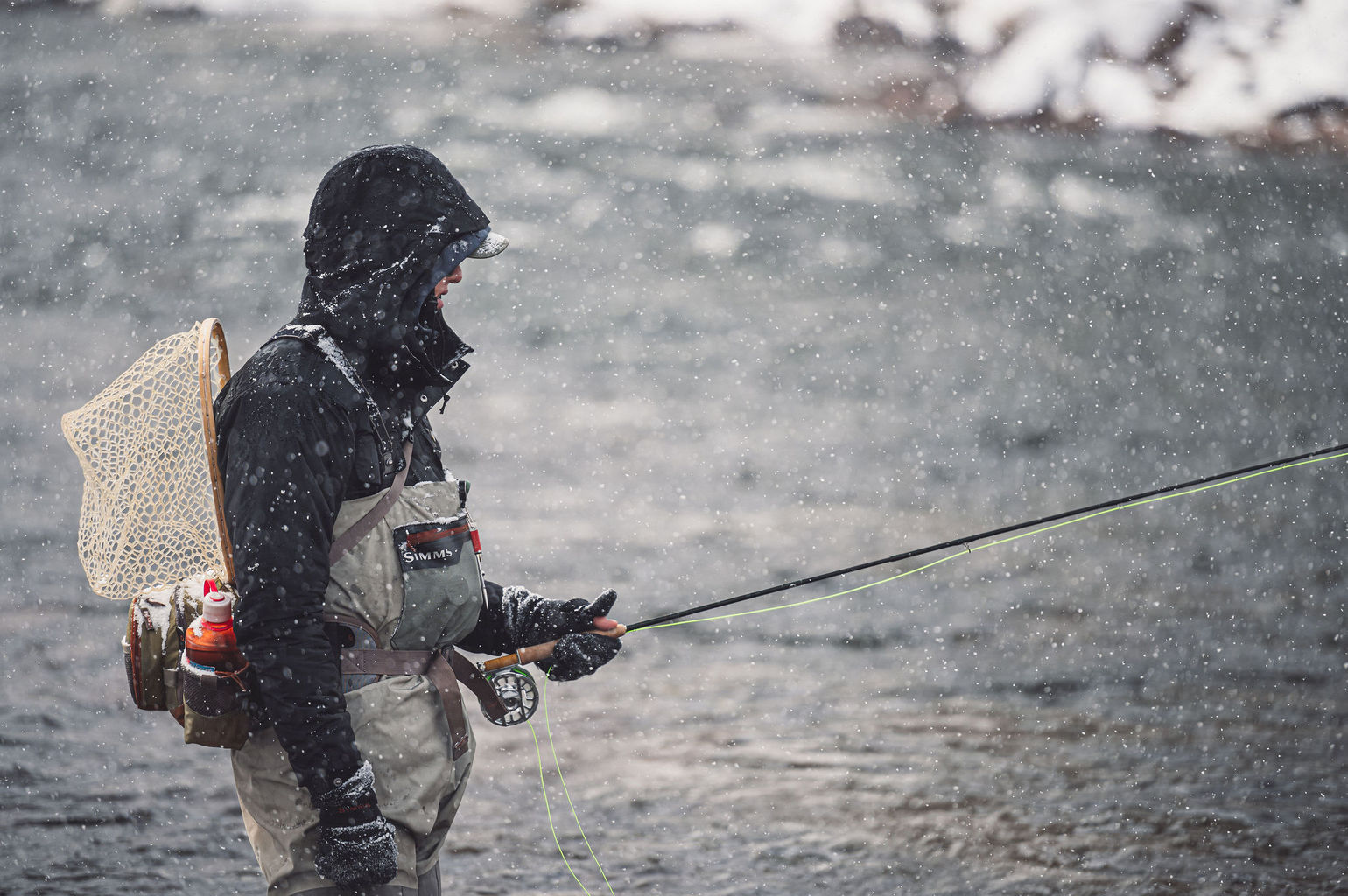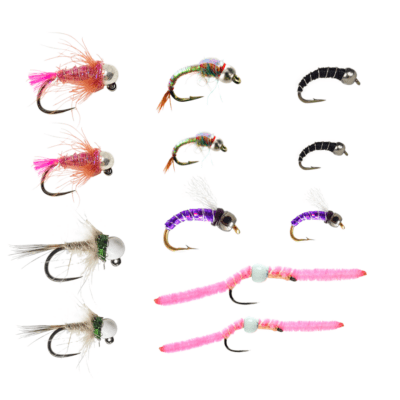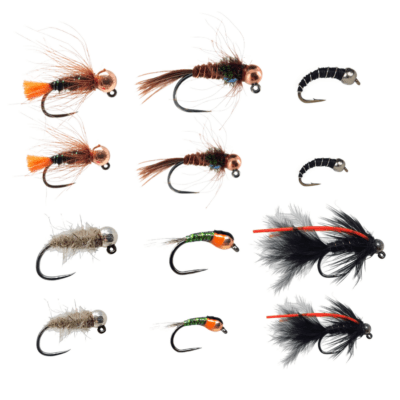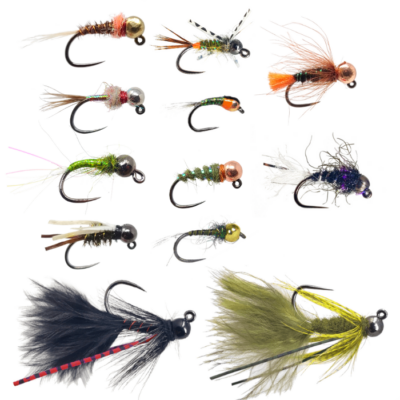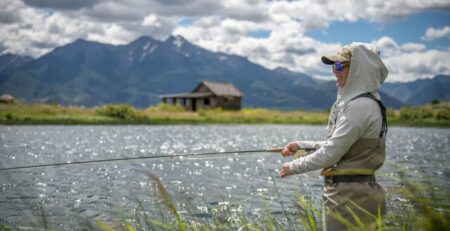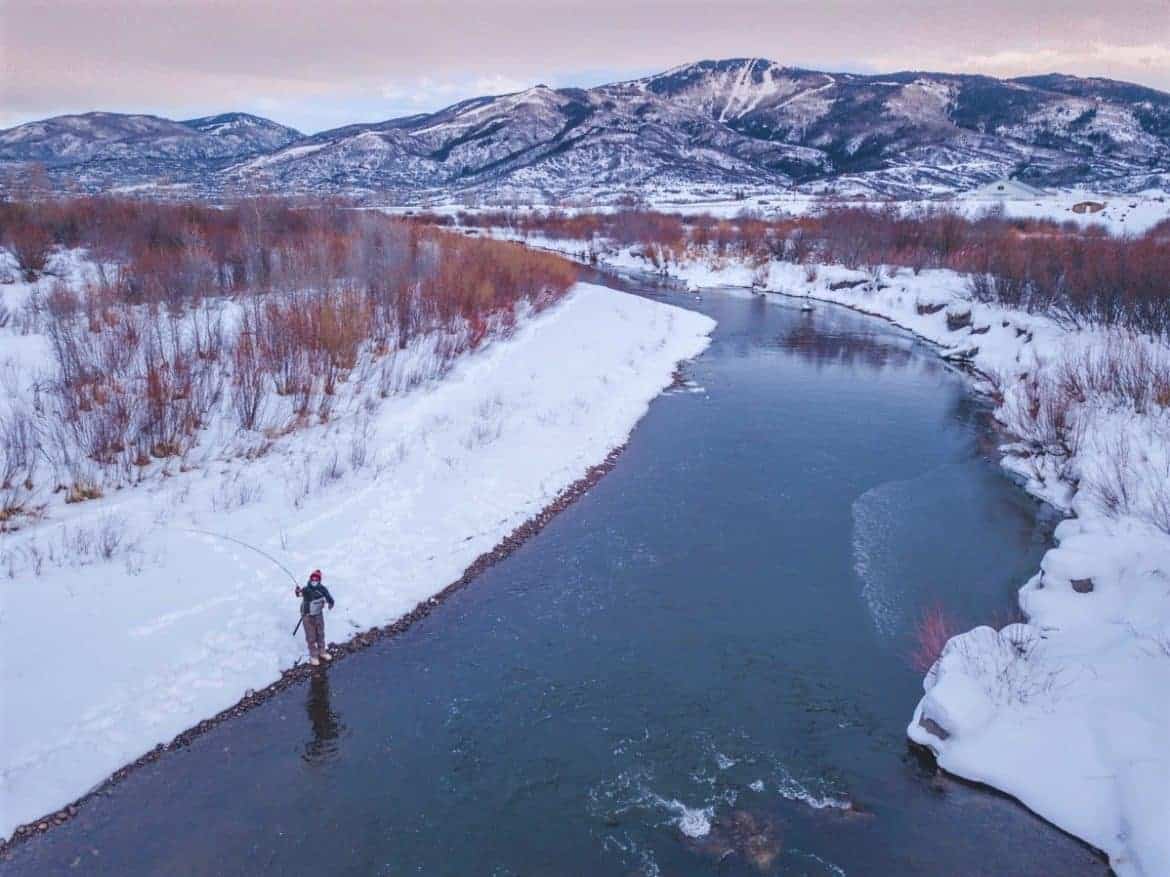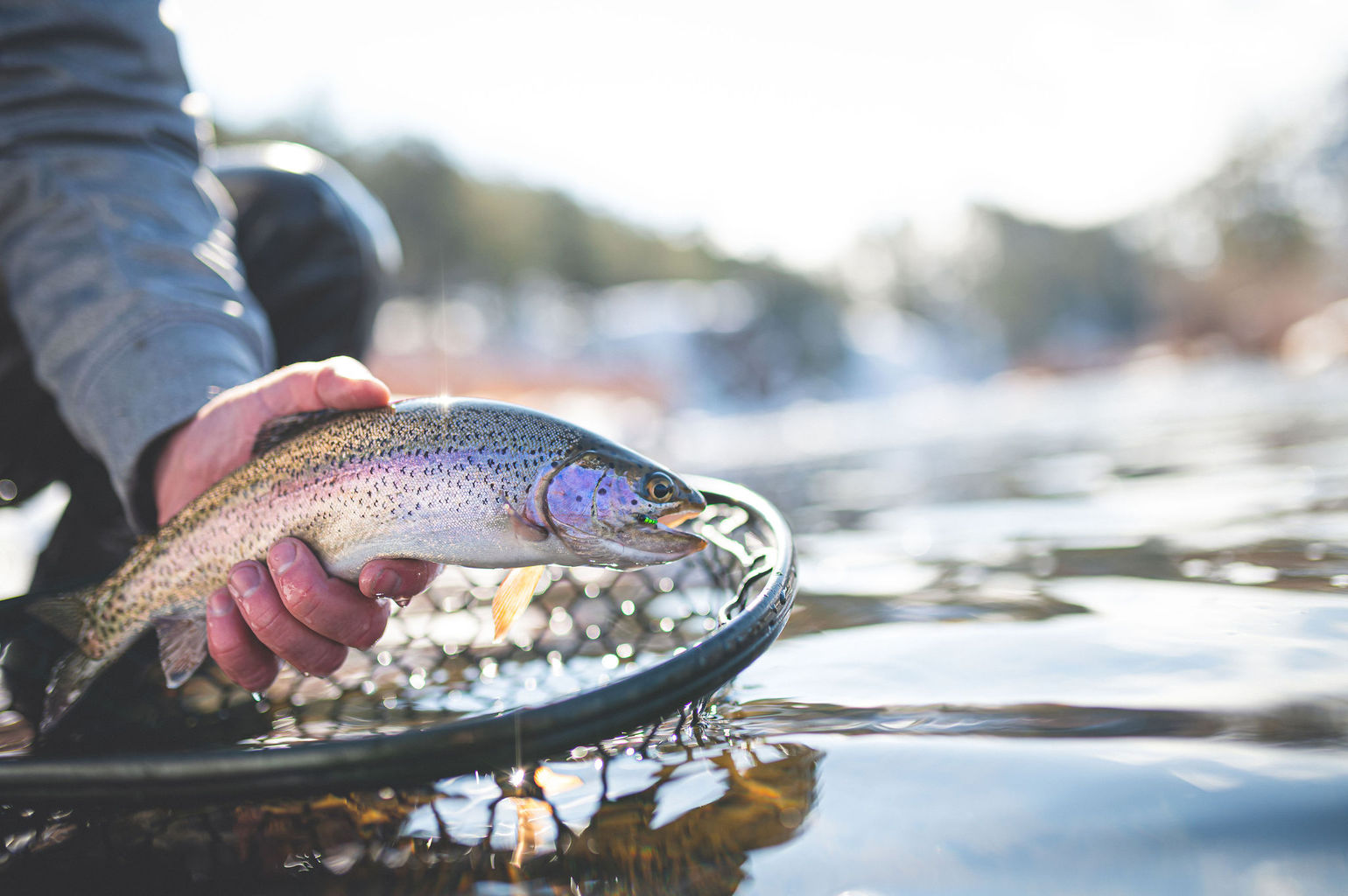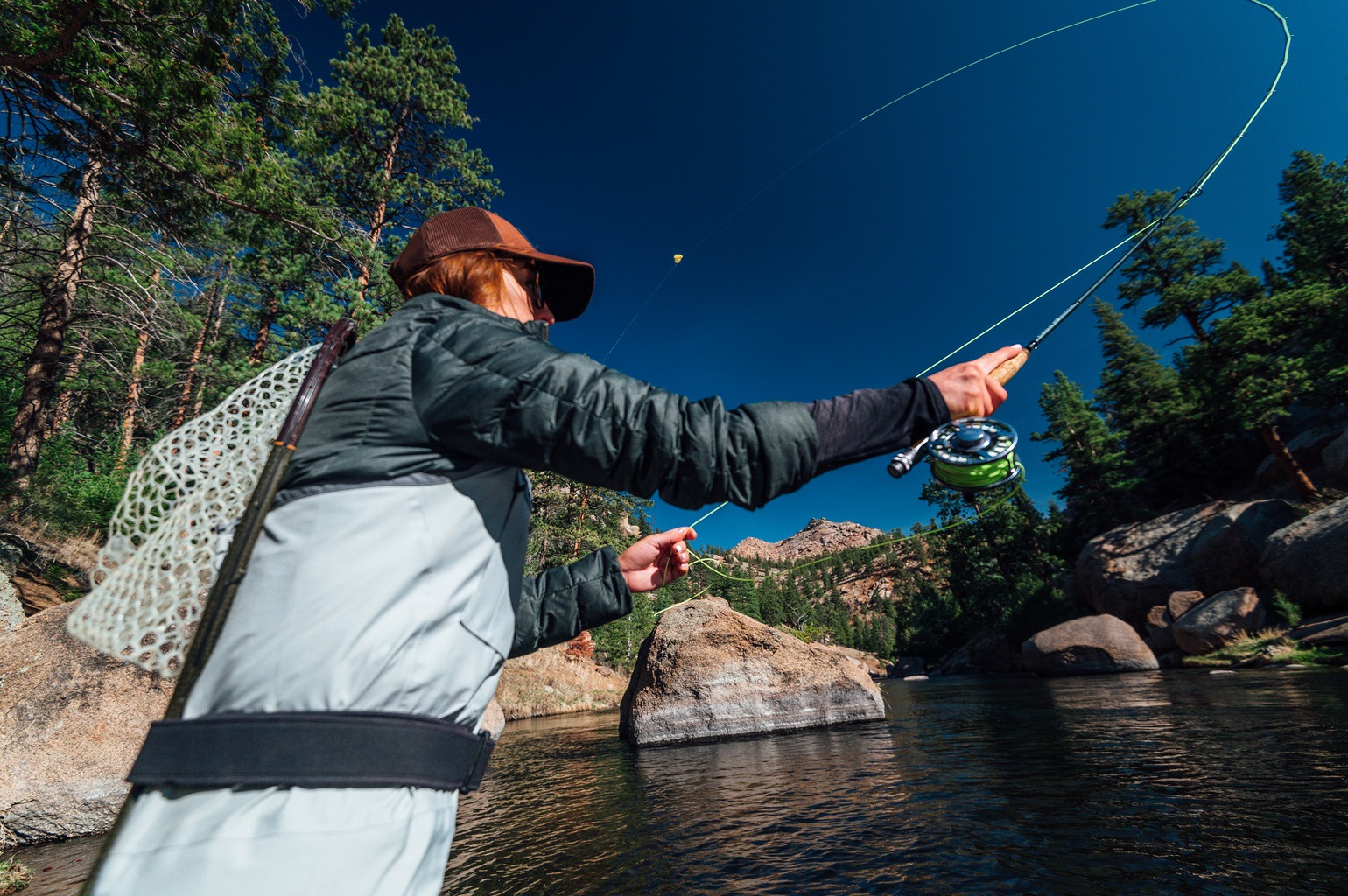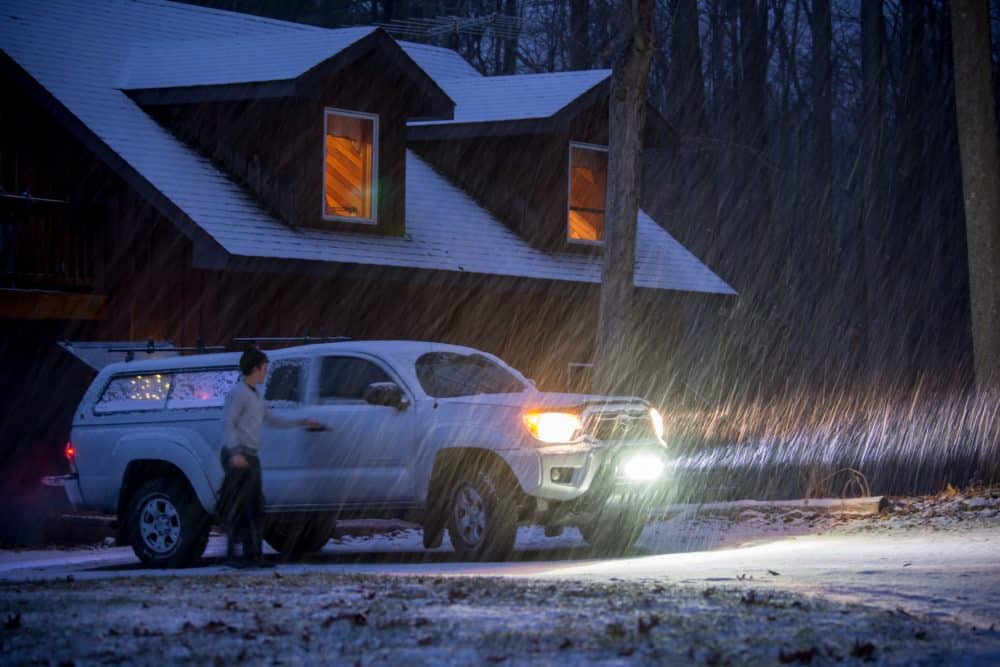How to Fly Fish for Trout in the Winter
Mountain towns in winter are bustling with snow skiing bound visitors. Restaurants are full, and the streets are crowded with families searching for the next best t-shirt shop or the best place to find a hot meal. These same people make the same trek to the mountains in the summer months to escape the oppressive heat. Instead of snow sports, they are equipped with the best waders, fly rods and fishing gear money can buy. Eager for trout fishing season, they long for a chance to catch a rainbow or brown trout on a fly rod in a cool mountain trout stream.
Most of these folks fail to realize, that some of the best fly fishing of the entire year can be found in the colder months of winter.
Fly fishing in the winter provides fly fishermen with ample angling opportunities that are often overlooked. Water temperatures are colder and air temperatures are usually below freezing, most anglers don’t consider winter fishing as a viable option when considering winter activities. Fish still need to eat, and you can find feeding trout all winter long. Winter fly fishing is an excellent opportunity to find solitude on otherwise crowded rivers. With fewer anglers present, winter trout tend to be less pressured and more willing to eat a fly.
Table of Contents
- Winter Fishing Gear
- How to Fish for Trout in the Winter
- What Flies to Use for Trout in the Winter?
- Where Do Fish Go in the Winter?
- Winter Fly Selection
- Fly Fishing Streamers in the Winter
This time of the year, much like most fly fishermen, trout tend to group up and hunker down in deep pools. The break from constant fly-fishing pressure gives them a chance to recover from warm summer water, the spawn, and being caught and handled all summer long. If you can brave the cold water (merino wool gloves are a must), winter is one of the best times of the year to go fly fishing. You will find 1/10th the number of anglers on your favorite river, and despite the frigid air temperatures, there are still plenty of opportunities to catch fish.
Hopefully, these winter fly fishing tips will help you approach cold weather fishing scenarios and take advantage of everything fly fishing in the winter has to offer.
Winter Fishing Gear

Winter fly fishing is all about comfort. The better you feel while fishing the longer you will be able to stand inclement weather and cold water. First and foremost, a good set of gloves and high end waders are crucial. Neoprene gloves, merino wool gloves, or quick dry fleece gloves with removable fingers are game changers. Whatever you choose, look for gloves that are low bulk and allow you to use your fingers when needing to change fly rigs.
Breathable waders with a neoprene foot stocking are must haves. Paired with layers of long underwear, wool socks, fleece layered clothing, and a light down puffy jacket, you will stay warm all day. A jacket with a hood is also strongly recommended. Placing a hand warmer in the chest pocket of your waders is a bonus, and it comes in handy when you need to warm your fingers after getting wet.
Fly Fishing Made Easy 👍
Our Quarterly Fly Club ships 1,000’s of flies to anglers all across the United States. Receive curated fly assortments selected for the season with in-depth articles on how to fish them. Great for beginners to learn and for intermediates to discover new flies.
Ice on your rod’s guides can often be a problem when you are fly fishing in the winter. Taking time to clear your rod’s guides is important, but can also become annoying if you are having to stop every other cast to adjust your fly line and manually de-ice. Loon makes Stanley’s Ice Off Paste, which is specifically formulated to keep ice off of fly rod guides. Most fly shops carry Loon products. If you don’t live near a well-stocked fly shop, Chapstick and Pam cooking spray are also well-known homemade remedies for deicing rod guides. They are both cheap and easy to find as well. Chapstick has the same feel as Stanley’s and reduces ice buildup. Plus, it is doubly useful for chapped lips which are common during winter angling!
How to Fish for Trout in the Winter

Most rivers are open to fishing in the winter. However, some states have a trout fishing season with river closures depending on the time of year. We recommend that you check your state and local angling laws to see if watersheds are open for winter fly fishing.
Fortunately, whether you live in the Eastern, Western, or Southern United States, there are plenty of rivers and tailwaters that offer ice free fly fishing opportunities on some incredible pieces of water.
Here is a list of some of the best winter tailwater trout fly fishing destinations in the lower 48 states:
The Blue River – Colorado:
This is one of our favorite places to fish in the winter. The section up by the outlet mall in Silverthorne is ok if you need some quick fishing. The best and often most overlooked area is the section North of the town of Silverthorne along highway 9. The section upstream from Green Mountain Reservoir, is remote and stacked with fish. There is a lot of private land here, but hikes off of Hwy 9 provide less pressured water.
The Fremont Canyon of the North Platte River – Wyoming:
Fremont Canyonis a phenomenal place to wade fish, and most days, especially in the winter, the landscape is free of people. Lots of big fish and dry fly action happens here. Fishable water is relatively short, but it has many features for trout to live and play in.
The South Platte River – Colorado:
The South Platte offers anglers lots of cold weather fishing opportunities. Always ice free in the winter. The “Dream Stream” sees plenty of dry fishing days, even in the coldest of winters. Eager trout willing to eat small dry flies make this a fun winter fishery.
The Guadalupe River – Texas:
Yes that’s right, there are rainbow trout in Texas. The Guadalupe River offers 15 miles of tail water fishing, and has been named one of the countries top 100 trout streams. The fish are surprisingly large here and a cold day is in the 40’s.
The Norfork and White River System – Arkansas:
The White River in Arkansas is the top destination for throwing winter time streamers and catching giant fish. The largest brown trout in North America live here, and it is not uncommon to catch fish in the 5-10 lbs. range.
The South Holston and Watauga Rivers – Tennessee:
Both are great year round options for fly fishing, especially in the winter. The South Holston and the Watauga Rivers offer anglers a float fishing option in the Eastern part of the United States. Nymphing scud and midge patterns, as well as throwing streamers can produce the largest brown trout in the Southeast.
What Flies to Use for Trout in the Winter?

As fall turns to winter and the water temperature drops, trout tend to go into a lethargic hibernation. Trout feed more selectively throughout the day when food is present in the water, this typically happens in the middle of the day when the sun is at its peak.
You’ll notice feeding increases drastically once the winter sun starts warming up the water. The abundant summer hatches are over, and in the winter months, the menu of aquatic insects is drastically reduced. Food available for consumption is present but much more limited and usually in much smaller hook sizes; think size #16 and smaller.

Zebra Midge
The quintessential midge pattern for anglers across the country! When tied in a variety of colors (silver, copper, and red primarily) the zebra midge can imitate any number of insects trout might be feeding on in tailwaters or freestone streams. This is a great choice for new water or those days when bug activity seems to be nil.

Juju Bee Midge
Midges are the name of the game from November through February, and the juju bee is near the top of the list in terms of productive flies. The sparse wings near the head of the fly will move just enough water to stimulate the interest of trout without being too far off from what the naturals look like.

Hi-Vis Griffith’s Gnat
Many streams maintain a nearly constant temperature year-round from reservoir releases and springs. This promotes healthy insect populations and activity. Having Griffith’s Gnat in sizes ranging from size #16 to size #22 is a good idea.
When active is low on the surface, you can always perform an unpopular act — sinking your dry fly in a nymphing rig. Placing a small midge dry fly, such as a size #20 or #22 Griffith’s Gnat, can do quite well as a wet fly. In fact, a good friend of mine does this frequently and with success — he actually recommends it every time we take a trip. And, he’s not wrong. It definitely works.

BWO Perdigons Imitations
The most consistent mayfly activity anglers can count on is the Blue Winged Olive (BWO). These insects hatch on most waterways throughout the state, making their nymph life stage a must-have in any fly box. A great strategy can be to fish a baetis BWO along with a midge to cover all ground on what the trout might be feeding on that day!

Parachute BWO
Few things match the excitement and feeling of accomplishment like catching trout on dries during the winter months. Using a BWO is about the only opportunity anglers have of avoiding squinting into the abyss looking for a minuscule midge dry, so carrying a few parachutes in sizes #18 and #20 is key for success.

Blowtorch Jig
Even if you have little knowledge on jig nymphs and the method of tight-line nymphing (euro nymphing), they are a great nymph pattern to add into your arsenal. We discovered these patterns a couple years ago from a guide and fished these with success during runoff up in the Boulder Canyon. Since then, it has been a go-to in our staffers’ multi-fly rigs.

Pat’s Rubberlegs
Most large streams and rivers have a healthy population of stoneflies, not just the one’s that host salmonflies. Use Pat’s Rubberlegs or the jigged Girdle Bug in a size #14 to #10 as your lead fly through riffles and deep pools.

Tungsten Rainbow Warrior Midge
One of the most successful searching fly patterns for trout, the Tungsten Rainbow Warrior Midge fly pattern combines a tungsten bead with a bit of flash to produce spectacular results.

Beaded Egg Fly
This fly is extremely effective during the spawning season in heavily stocked streams. Fish this fly downstream of the spawning area to awaiting trout. Although, during an abundant midge or baetis hatch, these will often be ignored.

Beaded Scud
There are so many scud patterns out there to choose from but this simple design is incredibly effective. It features a streak of flash on the back and copper ribbing for added durability. The presentation of this scud pattern is enough to fool hardy winter trout holding deep. Just get this fly down rolling near the bottom.

Beaded Woolly Bugger
Out of all the streamers available on the market, it is hard to beat the classic Bead-head Woolly Bugger. Typically, we like to fish a darker woolly bugger in black or olive in a smaller size by striping and swinging it through deep pools we know trout hold.
Fly Fishing Midge Hatches

Although the cold weather months have eliminated the mayfly, caddis, and terrestrial hatches, there are still food sources available. Midges are present all year long, and they become the main source of food when water temps drop. To the untrained eye, midges look very similar to mosquitos and they provide the bulk of winter hatches on winter trout streams.
Adult midges lay their eggs in the river. The eggs hatch and the midge larvae burrow into the sediment of the stream bottom. Eventually, the midge pupa swims to the surface and emerges through the meniscus of the surface film. Midges follow a life cycle of egg, pupa, larva, and then adult.

Even in extremely cold weather midges will continue to hatch and blanket the water. Oftentimes clumping together to form small rafts of bugs, they provide an excellent source of protein for winter fish.
Dry fly action in the winter is not uncommon when the conditions are right, and a thick midge hatch can bring hungry rainbows to the surface to eat a well presented dry fly on a dead drift. In the winter months, tail water fisheries like the Blue River, the Taylor River, and the South Platte have epic midge hatches.
Can You Fish Dry Flies in the Winter?

Yes, you can fly fish dry flies in the winter. It may be rather difficult to locate consistent dry fly fishing opportunities, especially on smaller local streams. Midges, blue-winged olives, and little black stoneflies are some of the only hatches you’ll be able to fish on the surface. But, midge fly hatches will be the most regular and biggest hatches throughout the entire season. On the other hand, fly fishing in the winter is guaranteed to be the most productive when using nymphing techniques.
Recommended Reading: How to Fly Fish Midge Dry Flies in the Winter
Personally, I have fished both the Blue River and South Platte River when the weather was below zero. One winter fly fishing excursion on the South Platte yielded some of the best dry fly fishing I have ever experienced. The cold water was painful but it was worth it.
The thermometer on the truck read -13 degrees. After an hour of drinking coffee in the truck, and contemplating if we should put our waders on, we made the trek to the river bank through a dense cloud of freezing fog. Much to our surprise, despite the freezing winter time temperatures and miserable cold, we were greeted with fish rising to a thick midge hatch. The flat water of the “Dream Stream” section of the South Platte was teeming with porpoising targets. The feeding activity was intense and the biggest trout were stacked in the upper water column of the river, eagerly eating both dry flies and emergers.
Fly Fishing Egg Flies in the Winter

Although midges are the primary food source during the winter, never underestimate the power of well drifted egg patterns fished under a strike indicator. In tailwater fisheries, trout can spawn year round, and many fish are keyed into egg patterns. The early fall, post brown trout spawn, will have fish looking for eggs. Trout intuitively know that are a valuable source of protein and shouldn’t be missed when given the opportunity. As winter winds down and the fishing season moves closer to early spring, rainbow trout start their spawning runs and eggs continue to be effective flies for catching fish.
Recommended Reading: How to Fly Fish Egg Flies
Where Do Fish Go in the Winter?

Fly fishing in the winter provides anglers the opportunity to find fish in different sections of the river as opposed to summer. Summertime fish are opportunistic feeders. In the summer there many factors that influence where trout hold in the river. The two main factors are insects present and water temperature (44 to 65 degrees Fahrenheit is ideal). The biggest fish in the river are going to be in prime lies, those which offer safety from predators and the first chance at easy meals.
In the summer, when water temperatures are right, trout will move from place to place to eat flies and aquatic insects. Thick hatches of summertime pale morning duns, caddis, and spring time blue-winged olives will bring fish up into shallow riffles. Trout in riffles are constantly in danger of being eaten by predators. The food source and hatches are so great during summertime, that at some point trout realize the benefit of eating food outweighs the risk of being eaten by birds of prey or other predators. In addition, as the hot days of summer drag on, the water warms up and the oxygen content decreases. This forces trout to move to faster more oxygenated sections of the river. Therefore, summertime trout can be found in deep pools, shallow riffles, and bouldery pocket water. They will also be found along turbid river banks, keyed into terrestrials and other hatching insects. The exact opposite it true for winter time trout.
Do Trout Go Deeper in Cold Water?

Winter trout will move out of their summer lies as the water cools and hatches decrease. In the winter months, besides midge hatches, there isn’t much else in the river to bring fish out from the safety of their prime lies. Even sunny days in the winter are too cold for insects to hatch. The lack of food, plus a decreased metabolism due to the cold water temperatures slow trout down. Highly oxygenated ice cold river water change where trout are going to live during the winter months.
Whether you are fishing in freestone streams or western tailwaters, winter trout are going to be found in much slower water. When approaching a river to fish in the winter, the first places that should be examined is slow water in general, deep slow runs, and the tail out of slower pools. Usually, deep slow pools will hold more fish, and sometimes you’ll find them stacked up by the hundreds in a very small space. Despite the cold environment, trout still need to eat. Well presented flies at the correct depth and size fly can yield many winter time trout.
Winter Fly Selection

When choosing fly patterns for winter fly fishing, think small flies. As we discussed above, not only is there a lack of food in the water, most trout will be in slow water. Slower moving water gives weary trout the opportunity to study flies and strike indicators before making a decision.
Think Small Flies
Most midge patterns range anywhere from sizes 18-24. Therefore, light 5x-7X fluorocarbon is critical when choosing the right tippet. Flies that you should have in your fly box should include but are not limited to: zebra midge, sparkle midge emergers, Griffiths Gnats and tiny parachute Adams (both dry flies), brassies, rainbow warriors, Cravens Jujubee midge, and crystal midges just to name a few! The zebra midge is a great place to start if your not sure which is the right fly to choose. Adjustments to fly choice can be made from there, depending on the situation.

Winter Trout Rigs
Many anglers choose a double nymph rig fished under a strike indicator as a good place to start when winter fishing. The first fly, or the point fly, can be a small rabbit strip leach or egg pattern. Small San Juan worms are a good choice too. The second fly tied off the bend of hook from the first fly or from the eye of the first fly, could be any of the midge nymphs that we mentioned earlier in the article.
As a rule of thumb, we recommend using a 9ft leader with an added 18″-24″ of fluorocarbon tippet from the leader to the first fly. The knot where you added the fluorocarbon to your leader, is where you add a piece of split shot. Since we are targeting fish in slow deep portions of the water column, it is critical that we add enough weight to get our flies to the correct depth.
Obviously, every river and fishing situation is different, but these are general recommendations and a good place to start. Adjustments to your flies and leader setup will need to be made on the water. Stealth is important in slow clear water, and you want to minimize false cast with the fly line as much as possible.
Other Winter Food Sources
Although most of the hatches are over during the winter. There a few other food sources that are still available for trout to eat. Sowbugs, scuds and Mysis shrimp are present year-round in most tailwater fisheries.
These three bugs are all part of the crustacean family. They hatch all day. Although they are very similar, the main difference between scuds and sowbugs is the profile. Scuds have a more shrimp-like look and sowbugs are oval and flat. Because scuds, sowbugs, and Mysis shrimp are present all year, it is a great idea to have a variety of these flies in your fly box. Trout key into food sources that are present all year, even if they aren’t present in great numbers.
Recommended Reading: How to Fly Fish Scuds
Unlike mayflies, which tend to burrow in the river floor or live under river rocks, scuds and sowbugs are mostly found in aquatic vegetation. Scuds and sowbugs look different depending on the body of water that you are fishing. In general, scuds range in color from orange to grey to tan. Sowbugs are typically shades of gray or olive.

When fishing sowbug patterns in the winter, depth is a critical factor when fishing crustacean fly patterns. While mayflies and midges can be found throughout the water column of the river hatching and emerging, scuds and sowbugs are going to be found deep. They are not terrific swimmers, so they do not move much within the water column. They are going to be found deep around the aquatic vegetation or the river rocks. A standard two-fly nymph rig like the one that we discussed above is sufficient. Ensuring that you have enough split shot to get your flies deep enough in the water column is the key. If you are not catching fish, before you change your flies, change your weight and depth by moving your strike indicator. Fish the flies on a dead drift, ensuring to minimize drag by mending. A mend is when you pick the lineup and flip it up stream. Try to do this without moving the strike indicator.
Fly Fishing Streamers in the Winter

If nymphing is too slow of pace for you. Winter fly fishing offers anglers the chance to fish streamer patterns and move bigger fish in the river. Setting expectations is important when fishing streamers in the winter. You will catch a lot more fish bobber fishing with a strike indicator, but streamer fishing gives you a chance at bigger rainbow and brown trout. Plus the fish attack streamers with reckless abandon. These strikes are much more fun than watching your bobber go down.
Streamers are fly patterns that imitate baitfish. In the winter, there isn’t any runoff from mountain streams, so river levels are low and the water is very clear. This time of year the fish are going to be deep near the bottom of the river, and the lethargic state of trout means that they are not going to move long distances to eat flies. Choose a sparser streamer that has a low profile. Unlike summer and spring when it is important to choose larger patterns that move water, winter fly fishing with streamers allows anglers to choose more classic patterns: wooly buggers, tequila sunrise, Sculpzillas, Muddler minnows, and smaller articulated flies like micro game changers are all great options.
You will want to throw streamers with a heavier fly rod. Traditional nymphing rods are generally 5 and 6 weight rods with a weight forward floating fly line. Depending on the size of the river and streamers that you are fishing, moving up to a 7-weight rod with a floating line is a solid decision that will make casting much easier. In addition, since the fish are deeper this time of year, it is a good idea to have a backup fly spool loaded with a sinking line. Sinking fly lines help get lighter streamers down deep to where the fish are holding.
Recommended Reading: How to Fly Fish Streamers
Since fish are more lethargic this time of year. You are going to fish streamer patterns differently in the winter then you would in the summer. Summertime fish can be fished to aggressively, often willing to move to eat a fly. Streamer retrieves in warm water can be fast, jerky, and downright combative. Winter streamer fishing is going to be slow and deep. Retrieves with longer slower strips can provoke eats. Sometimes, no strip at all and dead drifting streamers works well. Letting the fly tumble and swing through the water column will bring on strikes.
When streamer fishing in general, but especially in winter, think about where you want to fish and move accordingly. Unlike nymphing where you might spend lots of time picking apart a particular piece of water, with streamers you want to move and cover lots of water. The goal is to put the fly in front of as many fish as possible. Cast and move, cast and move, trying to cover every deep ledge, hole, and run with good depth and slower current.
Weather plays a major role in when to get the streamer rods out. Since it is so cold, keep an eye out for the outside temperature. As the temperature climbs on warmer days this is the time to put down the nymph rods and pick up that 7-weight streamer rod with a sinking fly line. Trout are sensitive to water temperature changes, and the smallest increase in the winter water temperature can put them in an aggressive mood.
Fly Fishing Made Easy 👍
Our Quarterly Fly Club ships 1,000’s of flies to anglers all across the United States. Receive curated fly assortments selected for the season with in-depth articles on how to fish them. Great for beginners to learn and for intermediates to discover new flies.

